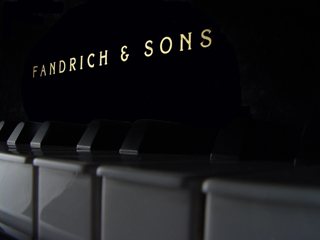 |
 |
Home | Pianos | Comments | Feedback |
| Home of the one and only Fandrich Vertical Action that plays like a grand. |
|
Home Pianos Accessories Refinishing News Recognition Comments Questions Feedback Fandrich Action Features Philosophy About Us Contact Us Links Tools |
|
| "When I started looking for a vertical piano I set out to get a good one. First, I read Larry Fine's book cover to cover. Then I went to 15 piano shops in the San Francisco Bay Area and played about 50 pianos from 14 different piano manufacturers. I also used the Internet to ask questions of registered piano technicians on their opinions of the tuning stability, manufacturing quality, serviceability and general opinions of the pianos I had played. Finally, I retained a consultant, the president of the local piano technician's guild, to supplement my musician's-ear approach to evaluating pianos. He told me not to make a decision before going to see Darrell Fandrich's pianos. By far the single most important factor, however, was my own ears. I played many vertical pianos that were over $20,000 that were uneven across the scale. I played many others that, despite the illustrious name on the fallboard, had part but not all of the tonal qualities I was seeking. Basically, at a premium price I could find brightness and tonal clarity or I could find warmth and richness. But I couldn't find both these qualities in one instrument. Until I visited Darrell Fandrich. I chose the 49" Wilhelm Steinberg vertical piano outfitted with the Fandrich & Sons action. I found this piano to have a superb action, very smooth scale and a sound that integrated the best of the European clarity and American warmth that I had been seeking. I didn't make this decision on price, but I was pleased that the piano that really made my heart sing was less than half the price of what the instruments I was comparing it to sell for. I was also very impressed with the 6'11" Fandrich & Sons grand. I have played many, many Steinway B series grands over the years. (In fact, it has also been 20+ years since I played a really good New York Steinway.) But the Fandrich & Sons grand had it. It had the same kind of singing lyricism as a really good New York Steinway prepped right. I was thrilled. And to think that this piano sells for $26,000! If I had the room in my house for a grand I would have taken the piano home with me right then. My advice to other piano shoppers is that Fandrich & Sons pianos are targeted at a particular segment of piano buying population; Those that: 1. Have good enough ears to recognize a really good instrument when they see it 2. Are driven more by musical considerations than those of status aka 'fallboard fixation' 3. Are not sufficiently wealthy to eliminate price from being an issue to which they pay attention If you find yourself in the same category as I then you owe it to yourself to try out Fandrich & Sons pianos and let your ears be the judge. I flew all the way from San Francisco and am delighted I did." -- Terry Tippie Contact information available upon request. |
| Copyright 1997-2024 Fandrich & Sons. All rights reserved. |  |
